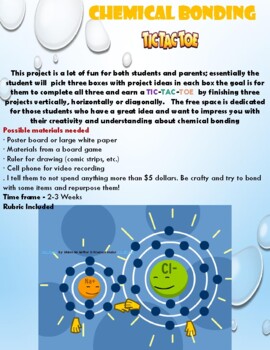Chemical Bonding Tic-Tac-Toe Project
- PDF
Description
Project Based Learning Summative Project - To be completed after both ionic and covalent bonding have been discussed.
Learning goal for this activity
1. Students will compare the process of covalent and ionic bonding
2. Students will understand what takes place during ionic bonding and covalent bonding
3. Students will explain how ionic and covalent bonds are same and different.
4. Students will identify ions and lewis structures
Critical vocabulary you must address in your three products.
Cation, Anion, Lewis Structures, Valence Electrons, Electrons, Electronegativity.
Possible materials needed
· Poster board or large white paper
· Materials from a board game
· Ruler for drawing (comic strips, etc.)
· Cell phone for video recording
Time frame - 2-3 Weeks
Rubric Included





